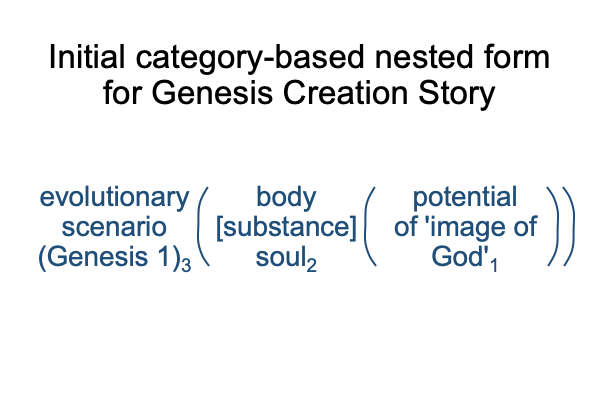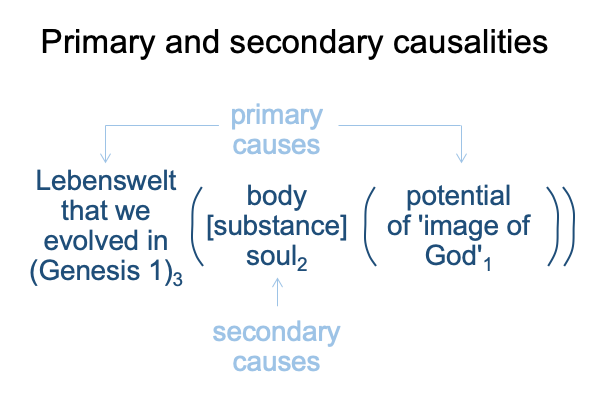0011 For humans and animals, the hylomorphe is body [substance] soul2.
According to A Primer on the Category-Based Nested Form, actuality2 is potentiated by the possibility of ‘something’1 in a particular normal context3.
0012 In Genesis, humans are created twice.
Chapter two presents a fairy-tale creation.
Chapter one offers an evolutionary-style scenario, consisting of a progression of days which build on one another. Some say the Creation Story describes the making of the tent (or temple) of the heavens and the earth. In the final act of this tent-construction, God intends (Gen. 1.26), then creates (1.27), then blesses (1.28), then gives plants as food (1.29) to us, who are created in His image. He then tells us to give fodder to the animals (1.30).
0013 In the triadic structure of the Genesis Creation Story, an evolutionary scenario3 brings the dyadic actuality of our kind2 into relation with the monadic possibility of ‘being an image of God’1.

0014 The logics of normal context3 include exclusion, alignment and complement. Clearly this normal context3 excludes (what we now call) original sin. How can an image of God already be fallen?
Christians who speculate that Adam and Eve are the first humans, based on their independent manufacture in the Garden of Eden, fail to notice the gap between Genesis 2.3 and 2.4. The gap is similar to the pause between different movements in a single work of classical music. Everyone knows that one is not supposed to applaud during this awkward moment, when the musicians flip pages and wait for one another to get into sync. This brief interval is supposed to be ignored. This is precisely what many interpreters of Genesis do.
0015 The fairy tale manufacturing of Adam and Eve manifests a different normal context than the creation of humans in an evolutionary dance between God speaking and the earth bringing forth in response to His commands.
What does this imply?
Adam and Eve associate to our current Lebenswelt.
The creation of humans in the image of God goes with the Lebenswelt that we evolved in.
Adam and Eve associate to original sin.
Humans in the image of God touch base with original justice.
Adam and Eve eat from the tree of the knowledge of good and evil.
Humans in the image of God, like prelapsarian Adam and Eve, enjoy the gifts of the tree of life.
0016 Neither Aquinas nor Houck draw these associations. These associations are implicit in their discussions.
0017 How does original justice contribute to my appreciation of the initial category-based nested form?
In Comments on Fr. Thomas White’s Essay (2019) “Thomism for the New Evangelism”, the issue of primary and secondary causality arises. Primary causality associates to normal context3 and potential1. Secondary causality, often confounded with material and instrumental causalities, points to the independent workings of actuality2.
Here is how that looks.

The primary cause of our creation associates to original justice. The secondary cause associates to our actualization as the image of God. The image of God1 potentiates the hominin body [and] soul2 in the normal context of the Lebenswelt that we evolved in3, as indicated, imaged and symbolized by the first chapter of Genesis.
